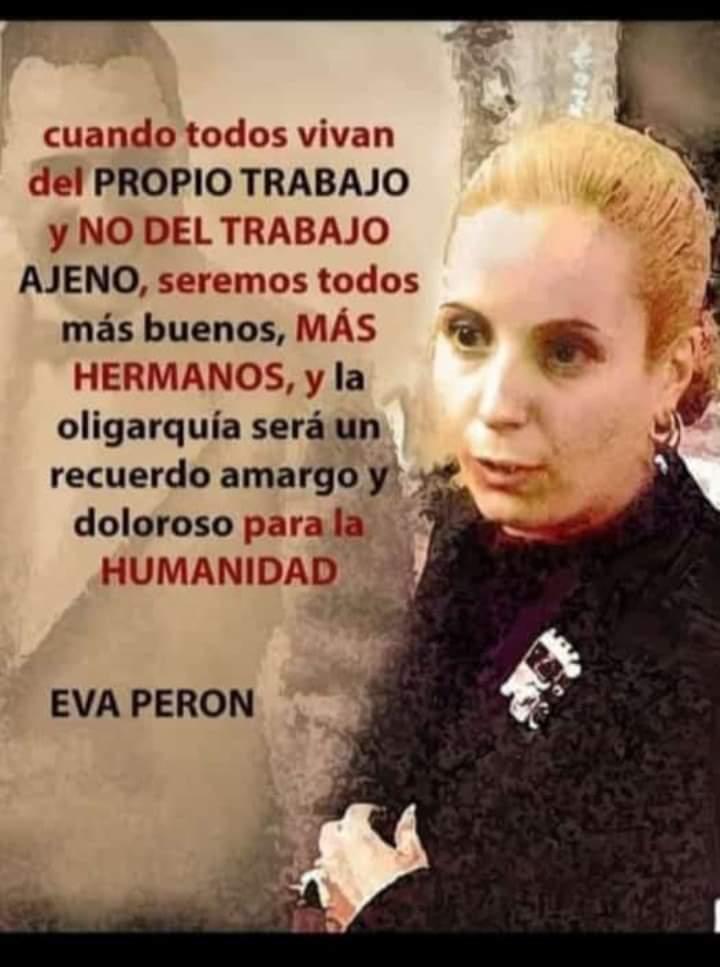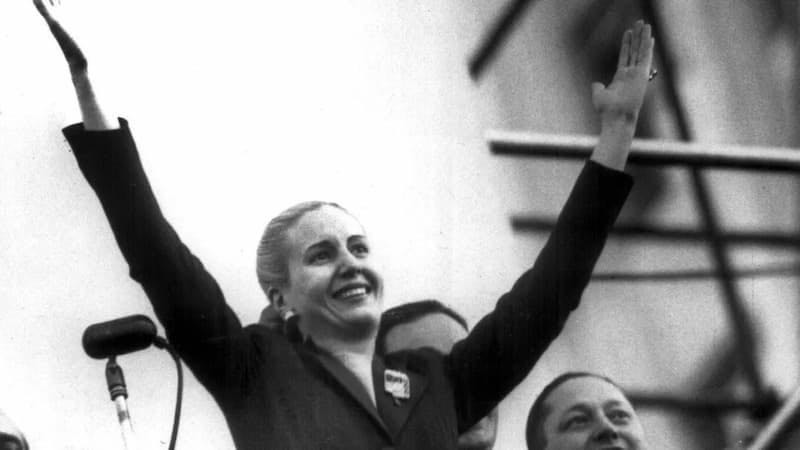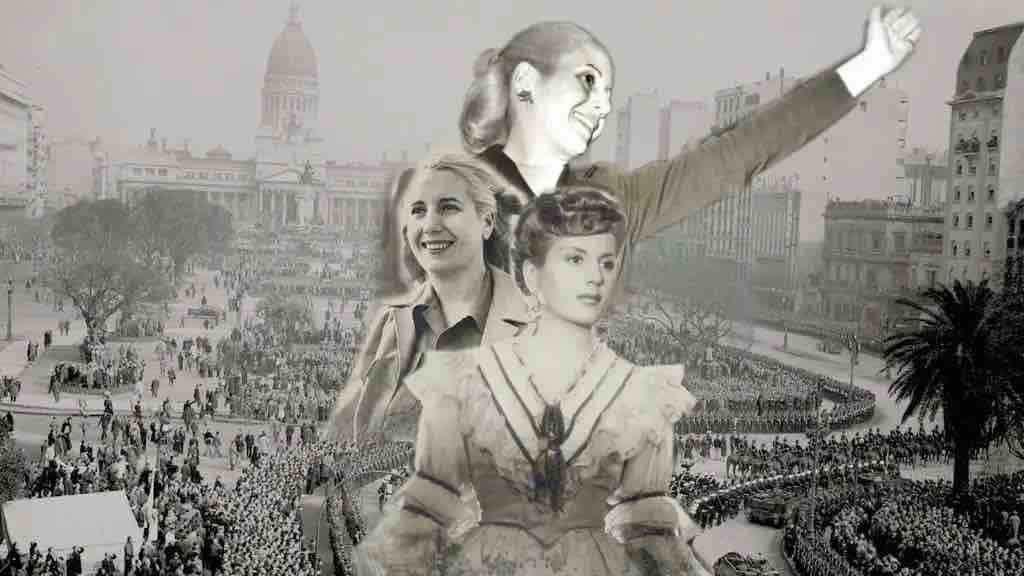By Karin Silvina Hiebaum
International Correspondent
Far from my homeland, on the banks of the Danube, I think of a May 7, 103 years ago, and that feminine face and that passionate love for Argentina, which she transmitted through the generations.
I am very proud to be able to write this article originally in German for the Vienna Standard newspaper, where the name «Evita» is a symbol of leadership and EMPOWERMENT.

Evita’s story
Married to Juan Domingo Perón, she founded the Peronist Women’s Movement, promoted women’s suffrage and carried out social works.
Eva María Duarte was born on May 7, 1919, 100 years ago. She was the wife of Juan Domingo Perón, one of the most remembered former Argentine presidents in national history and with the greatest impact on politics in the last century. Considered one of the most influential women in Argentine politics, ‘Evita’ aroused passions and hatreds during her short life. Her story, in 33 facts.
She was born on May 7, 1919 and was the fifth daughter of Juana Ibarguren from her extramarital affair with Juan Duarte. Her father was a conservative politician who supported two families at the same time. In addition to living with his legal wife and six legitimate children, he maintained a relationship with Eva’s mother. Although the place of her birth is not entirely clear to historians – some indicate that it was in General Viamonte and others in Junín – it is estimated that it took place in the Buenos Aires city of Los Toldos.
The uprooting of her family history
When her father died, Eva’s family was left unprotected. By then Juana Ibarguren had already settled with her children in Los Toldos, where she began to work as a seamstress to support her children.
When she was only 15 years old, she decided to leave home and start her career as an actress in the city of Buenos Aires. After different incursions in the cinema and on magazine covers, she managed to get a chance in the world of acting in radio theaters.
In April 1938, at the age of 19, she headed the cast of the Compañía de Teatro del Aire together with Pascual Pelliciotta, another actor who, like her, had worked for years in supporting roles.

In 1941 she worked in three films: La carga de los valientes; El más infeliz del pueblo with Luis Sandrini and Una novia en apuros, by the American John Reinhardt.
The turning point in her life came on January 22, 1944 when, at an event held at the Luna Park stadium by the Secretariat of Labor and Welfare, during a solidarity collection in favor of the victims of the San Juan earthquake, she met Juan Domingo Perón, twenty-four years older than her.
They married on October 22, 1945. As husband and wife, the couple began to work together in the race for the presidency.
Juan Domingo Perón: The love of he Life
Hand in hand with Perón, Evita entered politics, became the «standard-bearer of the humble» and was the conqueror of women’s suffrage, with a first official speech that showed her support for women’s rights.
She founded the Peronist Women’s Movement and was an active promoter of women’s equality.
Eva developed a great social task that benefited the poorest sectors of the population, although she was also criticized for the alleged «indoctrination» she carried out by the exaltation of her image, as in the book «La razón de mi vida» (The reason for my life) or the primary education books. Even a province was named after her at one point in Argentine history.
She created the Eva Perón Foundation, at the head of which she carried out social works.
Both Eva and the former president had different adversaries throughout their lives. The censorship they imposed, especially in the world of performing arts, was notorious. The actress Libertad Lamarque, who in an interview told of the boycott she was subjected to by the politicians and finally decided to leave the country. «I didn’t need to use the word exiled, there are many ways to throw someone out: I was not mentioned in any newspaper, in any magazine, it was forbidden for anyone to approach me. In short, I was alone in Buenos Aires,» she explained.
In 1947 Eva and Perón began an extensive tour of different parts of the world, Spain, Italy, France, Switzerland, Brazil, Uruguay, where she served as a goodwill ambassador while taking note of the various social activities carried out in these countries to improve the social situation of workers and the underprivileged.
She created the Eva Perón Foundation, at the head of which she carried out social works and became an indisputable protagonist in the history of Argentine politics.
She sought to increase the political influence of women and founded the Peronist Women’s Party (PPF).
She built hospitals, homes for the elderly and single mothers, two polyclinics, schools, a Ciudad Infantil. During the holidays she distributed cider and sweet bread, helped the needy and organized sports tournaments for children and youth.
On August 28, 1948, he published his Decalogue of the Rights of the Elderly, a pioneering initiative in the struggle for the recognition of the elderly. Since then, the Day of the Elderly has been celebrated in the country on that date.
In 1949 Eva Perón sought to increase the political influence of women and founded the Peronist Women’s Party (PPF), led by women, autonomous within the movement, and organized from basic women’s units that were opened in neighborhoods, towns and unions to channel the direct militancy of women.
The political life
In 1951, for the first presidential elections with universal suffrage, the workers’ movement proposed Evita, as the population called her, as candidate for vice-president. However, she resigned from the candidacy on August 31, a date remembered as the ‘Day of Renunciation’, pressured by internal struggles in Peronism and society in the eventuality that a woman supported by trade unionism could become vice-president.
She wrote two books: La razón de mi vida (1951) and Mi mensaje (1952).
She received numerous recognitions and honors, among them the title of Spiritual Head of the Nation, the great Order of Isabel the Catholic in Spain from Francisco Franco, the distinction of Woman of the Bicentennial, the Great Cross of Honor of the Argentine Red Cross, the Distinction of First Category Recognition of the CGT, the Great Medal for Peronist Loyalty in Extraordinary Degree and the Collar of the Order of the Liberator General San Martin, the highest Argentine distinction.
Loved and even idolized by the working classes, she was also criticized and rejected by the wealthier classes of society.
On November 11, 1951, all Argentine women over the age of 18 voted for the first time and Evita did so from her hospital bed.
Evita’s illness became evident in January 1950, when she underwent an operation for appendicitis. There, the first symptoms of the cancer that afflicted her were detected. This is how doctors Oscar Ivanisevich and Abel Canónico related it.
Her last speech. On May 1, 1952, very weak due to her illness, she decided to participate in the act in Plaza de Mayo on the occasion of Workers’ Day. There, he spoke to his «descamisados». In a fragment of his words, he said: «Comrades, comrades: once again I am in the struggle, once again I am with you, as yesterday, as today and as tomorrow. I am with you to be a rainbow of love between the people and Perón; I am with you to be that bridge of love and happiness that I have always tried to be between you and the leader of the workers».
Eva with Juan Domingo Perón in one of her most remembered speeches.
Deteriorating health. Juan Domingo Perón himself said that one day before her death, Evita would have told him in a whisper: «Never abandon the poor, Juan, they are the only ones who know how to be faithful».
On the day of Evita’s death, the announcer Jorge Furnot read a communiqué on national TV: «The Undersecretary of Information of the Nation fulfills the very painful duty of informing the people of the Republic that at 8:25 p.m. Mrs. Eva Perón, Spiritual Head of the Nation, has passed away».
Eva Perón is the only person to whom the National Congress granted the title of ‘Spiritual Head of the Nation’, on May 7, 1952, on her 33rd birthday.
She died on July 26, 1952, at the age of 33 from uterine cancer. Her remains were first kept vigil at the Ministry of Labor, and then moved to the Congress. Her body was embalmed.
Hundreds of thousands of people paraded for days to bid farewell to the woman who had given the best years of her life to her social and political work.
A mourning period was declared for her death that lasted until August 11, 1952. s
For his death a mourning period was declared that lasted until August 11, 1952, and until that day there were no cinema, theater or sports shows, while the radios broadcast sacred music.
After his death the CGT declared a three-day strike. The CGT proclaimed her «Martyr of Labor» and requested the national government to decree the highest honors, declared mourning for 30 days, and at the same time ordered a work stoppage that would not affect essential services for 48 hours throughout the country.
The history of his corpse is another of the darkest pages of Argentina. After the fall of Peronism, her body was kidnapped and moved from one place to another and her remains were desecrated.
Eva’s body was embalmed.
It was not until 1976 that Eva’s body was handed over to her relatives.
Since then, her remains were buried in the Recoleta Cemetery in Buenos Aires where they rest forever. Her tomb is visited by hundreds of tourists every year.






